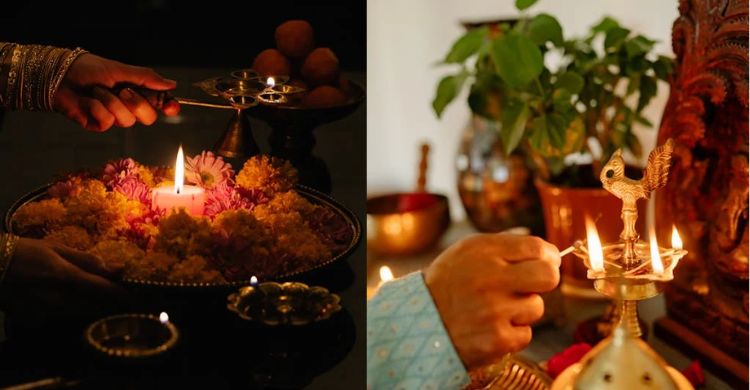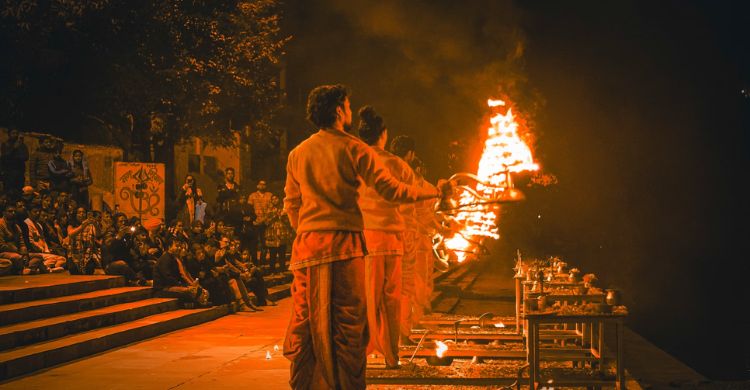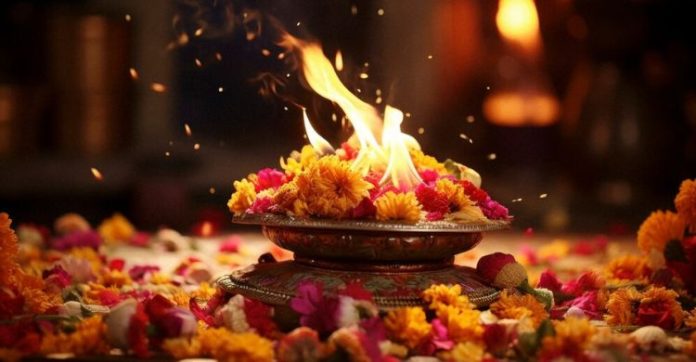In the heart of India, where spirituality flows through every street and temple, the ritual of performing Aarti stands as one of the most cherished expressions of devotion. It’s more than just a simple act of lighting a lamp or singing sacred hymns—it’s a moment of connection, a sacred bridge between the devotee and the divine.
Whether performed in a bustling temple or in the quiet of a home, Aarti is a timeless ritual that illuminates the path of devotion, filling the soul with light, peace, and gratitude.
In a world that often feels disconnected and fast-paced, Aarti brings us back to what truly matters—faith, reverence, and the joy of spiritual union. Let’s know about the profound benefits of Aarti and why it continues to be such an essential practice in India’s spiritual landscape.
What is Aarti?
Aarti, a luminous ritual of devotion, has its origins deeply rooted in ancient Indian traditions, blending sacred fire worship and temple practices into a spiritually enriching experience. It is much more than a simple act of waving a lit lamp before a deity—it is a symbolic gesture of offering oneself to the divine, a bridge connecting the devotee with the higher power.

Purpose and Importance of Aarti
Let us explore its historical roots and profound spiritual purpose.
The Vedic Roots of Aarti
The origins of Aarti can be traced back to the ancient Vedic traditions, where fire (Agni) was revered as a sacred medium of communication with the gods. In Vedic rituals known as homa or havan, offerings, like clarified butter, grains, and herbs, were placed into the sacred fire while chanting mantras.
These offerings symbolized a devotee’s surrender and gratitude to the divine.
Aarti evolved as an adaptation of these fire rituals, busing an oil lamp to make the sanctity of Agni more personal and portable. Its importance lies in its ability to encapsulate this ancient essence, making it accessible to everyone, whether in a grand temple or a humble home.
The Temple Connection
Another fascinating theory about the origins of Aarti relates to the architectural design of ancient Indian temples. Temples were often built with sanctums resembling caves, where the deity’s idol was enshrined in a dimly lit or dark chamber.
To reveal the deity’s form to devotees, priests would light an oil lamp and move it from head to toe in a circular motion. This act, accompanied by the chanting of Vedic mantras or prayers, not only illuminated the deity but also created an aura of reverence and devotion.
Over time, this ritual was refined and formalized into what we now recognize as Aarti. It became a profound expression of devotion, where the light of the lamp symbolized the devotee’s soul being offered to the divine.
A Combination of Tradition and Spirituality
The importance of Aarti transcends its historical origins. It weaves together tradition, spirituality, and cultural identity. This ritual brings communities together, fosters inner peace, and reminds humanity of its eternal quest for light amid darkness.
Symbolism: The flame represents the light of knowledge and divinity, dispelling the darkness of ignorance and negativity.
Spiritual Connection: By performing Aarti, devotees express gratitude and surrender to the deity, aligning their thoughts and energies with the divine.
Cultural Continuity: Aarti has been passed down through generations, becoming a cherished ritual that preserves India’s rich spiritual heritage.
Spiritual and Mental Benefits of Aarti
Performing Aarti isn’t just a ritual; it’s a powerful tool for inner transformation. Here are some Aarti benefits:
Promotes Inner Peace
The rhythmic chanting and circular motion of the diya during Aarti create a calming effect, helping to soothe the mind and promote tranquility.
Enhances Focus and Concentration
The repetitive and mindful nature of the ritual helps center the mind, improving focus and mental clarity.
Fosters a Divine Connection
Aarti deepens the connection with the divine, instilling a sense of surrender, gratitude, and devotion.
Dispels Negativity
The light of the diya, combined with devotional hymns, purifies the surroundings and removes negative energy, creating a sacred and positive space.
Encourages Mindfulness
Engaging in Aarti demands full attention, allowing individuals to practice mindfulness and stay in the present moment.
Reduces Stress and Anxiety
The harmonious vibrations of the chants and the warm glow of the lamp help reduce stress, bringing emotional stability and calmness.
Strengthens Emotional Resilience
Aarti provides comfort during challenging times, fostering hope, courage, and resilience.
Inspires Gratitude
The act of performing Aarti cultivates a sense of gratitude for the blessings of life, aligning the heart and mind with positive energy.
Builds a Sense of Community
When performed collectively, Aarti fosters unity, shared devotion, and emotional bonding among participants.
Reinforces Spiritual Discipline
Incorporating Aarti into daily life strengthens spiritual habits, encouraging consistent reflection and devotion.
Benefits of Aarti of Specific Gods and Deities
Performing Aarti for specific deities carries unique spiritual and mental benefits, as each deity symbolizes particular qualities and blessings. Here’s how Aarti for various deities holds profound significance:
Ganesh Aarti Benefits
- Removal of Obstacles: Ganesh, known as the remover of obstacles (Vighnaharta), blesses devotees with clarity and success when Ganesh Aarti is performed with devotion.
- Enhances Wisdom and Knowledge: Ganesh Aarti helps invoke intellect and wisdom, making it especially beneficial for students and professionals.
- Brings Prosperity: Chanting Ganesh Aarti attracts wealth, abundance, and good fortune in personal and professional life.
- Boosts Confidence: Ganesh’s blessings give devotees the courage and confidence to tackle life’s challenges.
Shiv Aarti Benefits
- Purification of the Mind and Soul: Performing Shiv Aarti, especially during the evening, helps dispel negative energies and purifies the environment.
- Spiritual Transformation: Lord Shiva is the symbol of destruction and renewal. Chanting Shiv Aarti invokes inner transformation, helping devotees let go of harmful habits and thoughts.
- Health and Longevity: Offering Aarti to Lord Shiva is believed to bestow good health, vitality, and long life.
- Connection with the Divine: Shiv Aarti fosters a deep sense of spiritual connection, instilling calmness and inner peace.
- Special Mention – Bhasma Aarti Benefits: The unique Bhasma Aarti performed in Ujjain Mahakaleshwar Temple is said to cleanse sins and invite divine protection.
Hanuman Aarti Benefits
- Strength and Protection: Hanuman Aarti invokes physical and mental strength, offering protection against fears, enemies, and negative influences.
- Courage and Fearlessness: Devotees feel empowered to overcome challenges with Hanuman’s blessings.
- Mental Clarity: Regular chanting of Hanuman Aarti sharpens the mind and helps maintain focus and discipline.
- Relief from Suffering: Hanuman Aarti is known for its ability to alleviate distress, offering relief from emotional and physical troubles.
Shani Dev Aarti Benefits
- Relief from Planetary Distress: Shani Dev Aarti is highly beneficial during difficult planetary periods (Shani Dasha), helping mitigate the effects of Saturn.
- Improves Karma: Worshipping Shani Dev through Aarti inspires good deeds and positive actions, reducing karmic burdens.
- Patience and Perseverance: Devotees develop patience, humility, and the strength to endure life’s challenges.
- Financial Stability: Shani Dev Aarti attracts stability and balance in financial matters, especially during tough times.
Ganga Aarti Benefits

- Spiritual Cleansing: Ganga Aarti performed on the riverbanks symbolizes the purification of the mind and soul, much like the sacred waters of the Ganges.
- Healing Energies: The vibrations of Ganga Aarti chants create a healing environment, promoting emotional well-being and peace.
- Forgiveness and Liberation: Offering aarti to Mother Ganga helps devotees seek forgiveness for sins and spiritual liberation (Moksha).
- Community Harmony: Ganga Aarti unites people, fostering a sense of collective spirituality and cultural pride.
Om Jai Jagdish Hare Aarti Benefits
- Universal Appeal: This Aarti is devoted to Lord Vishnu but is universally recited across households, symbolizing unity and inclusivity in worship.
- Gratitude and Contentment: Singing Om Jai Jagdish Hare Aarti instills a sense of gratitude, helping devotees appreciate life’s blessings.
- Peace and Harmony: The melodious rhythm of this Aarti soothes the mind, promoting harmony within and among individuals.
- Divine Protection: Chanting this Aarti invokes Vishnu’s blessings for safety, protection, and the preservation of peace.
- Material and Spiritual Prosperity: Devotees believe it brings balance, abundance, and spiritual growth in their lives.
How to Perform Aarti (Step-by-Step Guide)
Performing Aarti is a sacred ritual that combines devotion, discipline, and symbolic offerings to connect with the divine. Follow these detailed steps to perform Aarti correctly:
1. Preparations Before Aarti
Cleanse Yourself: Wash your hands, face, and feet to purify yourself before starting. Wear clean and modest attire.
Prepare the Worship Space:
- Place the idol or image of the deity in a clean, well-lit area.
- Decorate the space with flowers, garlands, and other offerings.
Gather Essential Items:
- A plate or thali (preferably made of metal).
A lit diya (lamp) with ghee or oil and a cotton wick.
Flowers, incense sticks, and camphor.
A bell, a small towel, and a vessel of clean water.
Aarti songbook or text (if needed).
2. Initiating the Aarti
Invoke the Deity: Begin by chanting prayers, mantras, or Bhajan Kirtans to invite the presence of the deity into the space.
Arrange Offerings:
- Place flowers, incense sticks, and other items on the Aarti thali.
Ensure the diya is adequately lit and placed at the center of the plate.
3. Performing the Aarti
Hold the Aarti Plate:
- Use your right hand to hold the plate while the left hand is free to ring the bell.
Start offering the items (flowers, incense) symbolically to the deity as a mark of respect.
Move the Lamp in Circular Motions:
- Hold the lit diya or lamp and wave it in clockwise circular motions in front of the deity.
- Focus on specific areas; begin at the feet, then the torso, and finally the head.
- Continue chanting Aarti songs or reciting mantras during this process.
4. Include Camphor Lighting
- Light camphor on the lamp toward the end of the Aarti. Its bright flame represents purity and devotion.
- Move the camphor flame in the same clockwise motion before the deity.
5. Ring the Bell
- While performing Aarti, gently ring the bell with your left hand. The sound dispels negative energies and fills the space with divine vibrations.
6. Conclude the Aarti
- Distribute Prasad: Share the blessed offerings (Prasad) with everyone present.
- Purification with Water: Take a few drops of water and sip it as an act of purification.
- Express Gratitude: Conclude with heartfelt prayers, thanking the deity for blessings and seeking protection and guidance.
- Replace the Lamp: Carefully place the diya back in its original position, ensuring safety.
7. Additional Considerations
- Perform Aarti with focus, devotion, and a calm mind to fully absorb its spiritual and mental benefits.
- Encourage participation from family members or devotees to foster unity and collective positivity.
This structured approach to Aarti honors tradition while creating a deeply spiritual experience. It connects you with the divine and uplift your spirit.
Why Aarti Is Relevant Today?
In an era dominated by technology, fast-paced lifestyles, and material pursuits, the practice of Aarti remains profoundly relevant. It serves as a timeless ritual that bridges ancient wisdom with modern spiritual needs, providing solace, connection, and purpose in a world often overwhelmed by stress and disconnection. Here’s why Aarti holds enduring importance in contemporary life:
Anchoring Spirituality Amid Chaos
- Mindfulness and Peace: Aarti creates a sacred pause, promoting inner calm in busy routines.
- Faith and Grounding: It helps reconnect with spiritual roots, offering direction during turbulent times.
Preserving Tradition and Culture
- Cultural Continuity: Aarti links generations, preserving India’s rich heritage.
- Community Bonding: It fosters a sense of belonging and cultural pride.
Mental and Emotional Wellness
- Stress Relief: The chants and lamp’s glow reduce anxiety and mental strain.
- Emotional Stability: Aarti nurtures gratitude, hope, and resilience.
Symbolism of Light in Darkness
- Negativity Removal: The diya’s light dispels darkness and ignorance.
- Inspiration: It motivates inner growth and enlightenment.
Universality of Its Message
- Inclusivity: Aarti embodies universal values like gratitude and devotion.
- Personal Meaning: It adapts to individual spiritual journeys.
A Daily Source of Positivity
- Start and End Well: Morning Aarti inspires positivity, and evening Aarti brings closure with gratitude.
- Higher Purpose: It reminds us to focus on ideals beyond material pursuits.
Revitalizing Homes and Communities
- Purification: Aarti cleanses the environment, creating peace at home and in communities.
- Family Unity: Performing Aarti together strengthens familial bonds.
Strengthening Faith in Adversity
- Spiritual Strength: It offers hope and courage during challenges.
- Gratitude: Encourages acceptance and alleviates despair.
Conclusion
The benefits of Aarti extend beyond spiritual realms, touching mental, emotional, and even social dimensions of life. Be it the Ganesh Aarti benefits, the grandeur of Ganga Aarti, or the universal appeal of Om Jai Jagdish Hare, each Aarti is a gateway to divine grace. In embracing this timeless ritual, we embrace peace, positivity, and prosperity in our lives.
Let the light of Aarti illuminate your soul and fill your life with boundless joy!



